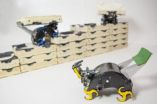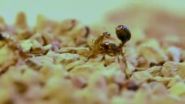(Press-News.org) Herpes virus proteins are more 'spaghetti-like' than previously thought, which provides a vital clue in the search for an efficient treatment against a type of herpes which causes a form of cancer known as Kaposi's sarcoma.
That's according to researchers from The University of Manchester who have discovered that the virus protein uses its flexible arms to pass on viral building blocks to the proteins of cells that it hijacks.
The latest part of this research is published in the February edition of PLoS Pathogens which has uncovered how the protein of cells hijacked by the herpes virus take on a 'spaghetti-like' structure.
The research provides the first ever molecular insight of how the herpes virus RNA, a type of molecule which helps to decode the generic blueprint of a virus, is transferred between viral and cellular proteins, thus helping the virus to hijack a cell. Dr Tunnicliffe, who is the first author of the paper, said: "Viruses cannot survive or replicate on their own - they need the resources and apparatus within a host cell to do so."
In their studies, funded by the Biotechnology and Biological Sciences Research Council, the research team developed and used a new methodology which revealed how exactly flexible proteins interact together and with RNA.
Dr Tunnicliffe continues: "We have developed a novel technique which reveals how flexible molecules work together; this allowed us a glimpse of how the virus is able to compromise the workings of the cell that it infects."
The research team has been using NMR – a technique related to the one used in MRI body scanners and capable of visualising molecules at the smallest scales – to examine how small components of herpes virus help it to multiply by binding themselves with other large molecules; this produced images of a monkey herpes virus protein interacting with mouse cellular protein and viral RNA. These images were then used to develop a 3D model of how viral RNA is recognised by this herpes virus protein and then passed on to the cellular protein of the host.
Although the model system studied here used protein from a species of herpes virus - which is only transmitted between squirrel monkeys, without actually doing much harm to them - these monkey herpes viruses are structurally very similar to viruses causing Kaposi's sarcoma in humans. Understanding how monkey viruses work may help to find ways to prevent this type of cancer in humans.
Senior researcher Dr Alexander Golovanov, from the Manchester Institute of Biotechnology and Faculty of Life Sciences, said: "Initially proteins were thought to interact only as fitting rigid bodies – as a lock and key, for example. The fitting key is inserted into the lock, and that sets the rigid mechanism of a lock in action. Then the understanding evolved - it was found that not all protein 'keys' are rigid, some are more like boiled spaghetti which can still operate the rigid lock successfully, by adjusting its shape."
Dr Golovanov continues: "Just recently, the 'fuzzy' protein complexes were discovered - it is as if not only the 'key' is made of flexible boiled spaghetti, but also parts of the lock itself are made of boiled spaghetti. This 'spaghetti mechanism' still manages perform a defined complex function, despite lacking rigidity. The viral proteins behave a lot like such spaghetti."
He added: "Unfortunately, no effective antiviral treatment is currently available, which suppress viral replication efficiently enough. Finding a weak spot in the virus, which can be used to prevent Kaposi's sarcoma in the future, therefore would make a significant breakthrough."
Professor Melanie Welham, BBSRC Executive Director of Science, said: "This is an interesting technique which will help us understand more about the herpes virus and could be applied in virology research more generally. This is the type of excellent bioscience research underpinning health that BBSRC seeks to fund to deliver social and economic benefits for all."
INFORMATION:
Notes for editors
The paper, 'Competitive and Cooperative Interactions Mediate RNA Transfer from Herpesvirus Saimiri ORF57 to the Mammalian Export Adaptor ALYREF,' by Richard B. Tunnicliffe, Guillaume M. Hautbergue, Stuart A. Wilson, Priti Kalra, and Alexander P. Golovanov, is available on request.
The Biotechnology and Biological Sciences Research Council (BBSRC) invests in world-class bioscience research and training on behalf of the UK public. Our aim is to further scientific knowledge, to promote economic growth, wealth and job creation and to improve quality of life in the UK and beyond.
Funded by Government, and with an annual budget of around £467M (2012-2013), we support research and training in universities and strategically funded institutes. BBSRC research and the people we fund are helping society to meet major challenges, including food security, green energy and healthier, longer lives. Our investments underpin important UK economic sectors, such as farming, food, industrial biotechnology and pharmaceuticals.
For more information about BBSRC, our science and our impact see: http://www.bbsrc.ac.uk
For more information about BBSRC strategically funded institutes see: http://www.bbsrc.ac.uk/institutes
Efficient treatment a step closer in the fight against cancer-causing herpes
2014-02-14
ELSE PRESS RELEASES FROM THIS DATE:
Robotic construction crew needs no foreman
2014-02-14
Cambridge, Mass. – February 13, 2014 – On the plains of Namibia, millions of tiny termites are building a mound of soil—an 8-foot-tall "lung" for their underground nest. During a year of construction, many termites will live and die, wind and rain will erode the structure, and yet the colony's life-sustaining project will continue.
Inspired by the termites' resilience and collective intelligence, a team of computer scientists and engineers at the Harvard School of Engineering and Applied Sciences (SEAS) and the Wyss Institute for Biologically Inspired Engineering at Harvard ...
'Sexy' underwear is not the only way to feel feminine on Valentine's Day, academic says
2014-02-14
AUDIO:
This is a Podcast recording of Dr. Christiana Tsaousi explaining her research.
Click here for more information.
TV makeover shows and glossy magazines can leave women feeling guilty for not wearing "sexy" lingerie – especially on Valentine's Day.
But in fact, many different types of underwear could make them feel feminine, according to an expert on underwear consumption.
Dr Christiana Tsaousi, a lecturer in marketing and consumption at the University of Leicester's ...
Study explores link between selling and leasing market prices for cars
2014-02-14
Changes in the selling prices of cars can be used to improve calculations for how much people should be paying to lease a vehicle, according to a new study.
Researchers from Norwich Business School at the University of East Anglia (UEA) and Athens University of Economics and Business (AUEB) have for the first time modelled the relationship between variations in leasing and selling market prices, using almost 10 years of data from the US, the world's largest automobile market. They suggest that in order to determine more accurately the monthly payments agreed in leasing ...
Cancer drugs hitch a ride on 'smart' gold nanoshells
2014-02-14
Nanoparticles capable of delivering drugs to specifically targeted cancer cells have been created by a group of researchers from China.
The multifunctional 'smart' gold nanoshells could lead to more effective cancer treatments by overcoming a major limitation of modern chemotherapy techniques—the ability to target cancer cells specifically and leave healthy cells untouched.
Small peptides situated on the surface of the nanoshells are the key to the improved targeting ability, guiding the nanoshells to specific cancer cells and attaching to markers on the surface of ...
First large-scale study of stock market volatility and mental disorders
2014-02-14
Falling stock prices lead to increased hospitalisations for mental disorders, according to new research published today in the journal Health Policy and Planning.
Researchers assessed the relationship between stock price movements and mental disorders using data on daily hospitalisations for mental disorders in Taiwan over 4,000 days between 1998 and 2009. They found that a 1000-point fall in the Taiwan Stock Exchange Capitalisation Weighted Stock Index (TAIEX) coincided with a 4.71% daily increase in hospitalisations for mental disorders.
A downward daily change in ...
Crazy ants dominate fire ants by neutralizing their venom
2014-02-14
VIDEO:
In this video, a fire ant dabs venom on an attacking crazy ant. The crazy ant coats itself with formic acid to neutralize the venom, a discovery made by University...
Click here for more information.
AUSTIN, Texas — Invasive "crazy ants" are rapidly displacing fire ants in areas across the southeastern U.S. by secreting a compound that neutralizes fire ant venom, according to a University of Texas at Austin study published this week in the journal Science Express. It's ...
Cat parasite found in western Arctic Beluga deemed infectious
2014-02-14
University of British Columbia scientists have found for the first time an infectious form of
the cat parasite Toxoplasma gondii in western Arctic Beluga, prompting a health advisory to the
Inuit people who eat whale meat.
The same team also discovered a new strain of the
parasite Sarcocystis, previously sequestered in the icy north, that is responsible for killing
406 grey seals in the north Atlantic in 2012.
Presenting their findings today at the 2014
Annual Meeting of the American Association for the Advancement of Science (AAAS), Michael Grigg
and ...
NOAA researcher says Arctic marine mammals are ecosystem sentinels
2014-02-14
As the Arctic continues to see dramatic declines in seasonal sea ice, warming temperatures and increased storminess, the responses of marine mammals can provide clues to how the ecosystem is responding to these physical drivers.
Seals, walruses and polar bears rely on seasonal sea ice for habitat and must adapt to the sudden loss of ice, while migratory species such as whales appear to be finding new prey, altering migration timing and moving to new habitats.
"Marine mammals can act as ecosystem sentinels because they respond to climate change through shifts in distribution, ...
Stanford psychologist shows why talking to kids really matters
2014-02-14
Fifty years of research has revealed the sad truth that the children of lower-income,
less-educated parents typically enter school with poorer language skills than their more
privileged counterparts. By some measures, 5-year-old children of lower socioeconomic status
(SES) score two years behind on standardized language development tests by the time they enter
school.
In recent years, Anne Fernald, a psychology professor at Stanford University, has
conducted experiments revealing that the language gap between rich and poor children emerges
during infancy. ...
For understanding family structure to trauma: New technology is yielding bigger data
2014-02-14
Austin - February 13, 2014 - Social media can do more than just entertain us and keep us connected. It also can help scientists better understand human behavior and social dynamics. The volume of data created through new technology and social media such as Facebook and Twitter is lending insight into everything from mapping modern family dynamics to predicting postpartum depression.
"By analyzing different types of social media, search terms, or even blogs, we are able to capture people's thinking, communication patterns, health, beliefs, prejudices, group behaviors – ...

